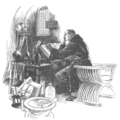Template:Did you know nominations/Summa Grammatica
Appearance
- The following is an archived discussion of the DYK nomination of the article below. Please do not modify this page. Subsequent comments should be made on the appropriate discussion page (such as this nomination's talk page, the article's talk page or Wikipedia talk:Did you know), unless there is consensus to re-open the discussion at this page. No further edits should be made to this page.
The result was: promoted by sst✈ (discuss) 09:58, 20 November 2015 (UTC)
Main hook promoted with image
| DYK toolbox |
|---|
Summa Grammatica
[edit]
Friar Bacon in his study
- ... that Roger Bacon's Summa Grammatica is sometimes considered to propose a universal grammar?
- ALT1:... that Roger Bacon's Summa Grammatica, apparently based on his lectures in Paris, survives in a students' copy?
- ALT2:... that Roger Bacon's Summa Grammatica follows Robert Kilwardby in analyzing Latin grammar on the basis of Aristotle's Physics?
- Reviewed: Verse of Wilayah
Created by LlywelynII (talk). Self-nominated at 06:42, 22 October 2015 (UTC).
 Article length and age are fine, multiple spot checks revealed no copyvio or plagiarism concerns, reliable sources are used and all the references to sources that are accessible online check out, AGF for the few that aren't. Hooks are all interesting; ALT2 is most interesting (imho) but it is only implied in the article, not stated outright, so I'm passing the main hook, it is referenced and the length is appropriate. Good start to an interesting topic, I can't believe we didn't already have an article for this! On a side note, "too many references" probably isn't a complaint heard much around here, but, in looking at the article as a casual reader (not as an editor), I found all of the notes and refs a bit distracting. Where possible, I would move the mid-sentence refs to the end of the sentence, and maybe even where a certain source is used multiple times in a paragraph, I would consider just noting it at the end of the paragraph. Again, that's probably just a style preference and, FWIW, just my two cents, in no way affecting the DYK nomination. All in all, nice work!--William Thweatt TalkContribs 01:02, 3 November 2015 (UTC)
Article length and age are fine, multiple spot checks revealed no copyvio or plagiarism concerns, reliable sources are used and all the references to sources that are accessible online check out, AGF for the few that aren't. Hooks are all interesting; ALT2 is most interesting (imho) but it is only implied in the article, not stated outright, so I'm passing the main hook, it is referenced and the length is appropriate. Good start to an interesting topic, I can't believe we didn't already have an article for this! On a side note, "too many references" probably isn't a complaint heard much around here, but, in looking at the article as a casual reader (not as an editor), I found all of the notes and refs a bit distracting. Where possible, I would move the mid-sentence refs to the end of the sentence, and maybe even where a certain source is used multiple times in a paragraph, I would consider just noting it at the end of the paragraph. Again, that's probably just a style preference and, FWIW, just my two cents, in no way affecting the DYK nomination. All in all, nice work!--William Thweatt TalkContribs 01:02, 3 November 2015 (UTC)
- Yeaaaah: here's my thought on that, just to let you know. You're absolutely right that in general if sentences A.B.C. in a paragraph are all sourced to the same cite, that we only need a cite after C and readers will be able to assume that A and B came from the same place. I've stopped doing that with new articles because what starts to happen is that sentences D and E and godforsaken lie Q get added into the middle of the paragraph... and still look like they're being sourced by C. It's a more-or-less unavoidable problem but that seems to at least show future thorough editors where to look for things that aren't coming from the same places... at least until the page has been around a while and is more or less stable. — LlywelynII 18:55, 3 November 2015 (UTC)
